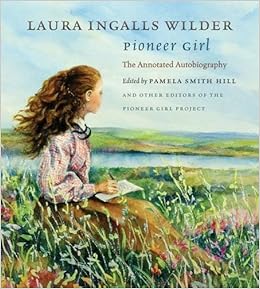 Pioneer Girl: The Annotated
Autobiography by Laura
Ingalls Wilder, edited by Pamela Smith Hill (South
Dakota Historical Society Press, 472 pages)
Pioneer Girl: The Annotated
Autobiography by Laura
Ingalls Wilder, edited by Pamela Smith Hill (South
Dakota Historical Society Press, 472 pages)
If,
like me, you devoured the Little House
books when you were a kid, then you need to get your hands on this
book. Not only does it give us Wilder's unadulterated memoir, but it
also provides us with a TON of information about everything you ever
wanted to know about pioneer life and the Ingalls/Wilder experience.
Hill's
exhaustive and detailed introduction explains just how this
never-before-published memoir was the basis for all of Wilder's
subsequent books for children about frontier life. In 1929 or 1930,
after her sister Mary died, Wilder decided to set down on paper
everything she could remember about growing up on the move, living at
various times in Wisconsin, Dakota territory, Kansas, Missouri, and
Minnesota. The memoir reads like a series of vivid scenes, many of
which were adapted and expanded for the Little House
books.
In
writing this memoir, Wilder realized that she had grown up during an
important and turbulent time in American history, when the frontier
was disappearing and white settlers were swarming over the continent,
illegally settling on Native American land and claiming it for
themselves. The Wilder family took part in the westward move in order
to find a better life and perhaps even prosper. Despite Charles
Ingalls' mutiple talents and ingenuity, though, the family often
struggled, moving around in order to take advantage of opportunities
that would keep them housed and fed.
The
life Wilder depicts was difficult, and at times dangerous, but she
took pleasure in remembering the cousins and friends she'd played
with, the singing and dancing schools she's attended, and the winter
festivities she'd participated in each year. Like her father, Wilder
looked forward to moving further west and seeing for herself what the
vast continent had to offer. She'd play on mud banks, wade through
creeks, and gaze across the prairie, even as she did her chores
around the house and helped take care of her baby sisters.
This
annotated autobiography offers us a more comprehensive picture of
Wilder's life and that of her family, filling in names and places,
and also correcting some of the changes that were made for the Little
House books (for instance, two
of her uncles were merged into one for purposes of consistency in the
children's books). We also have fascinating photos of the places
where Wilder lived (many photos are from the 1870s and '80s) and
images of her extended family and many friends.
You
don't have to read every single annotation or all of the textual
commentary, but they definitely enrich the reading experience. I see
this book as the kind of thing I can return to again and again,
whether it's to look up a specific piece of information, or just read
parts of the memoir again, because Wilder's style is so fluid and
inviting. So get yourself a copy from the South Dakota Historical
Society Press. You are welcome.
No comments:
Post a Comment